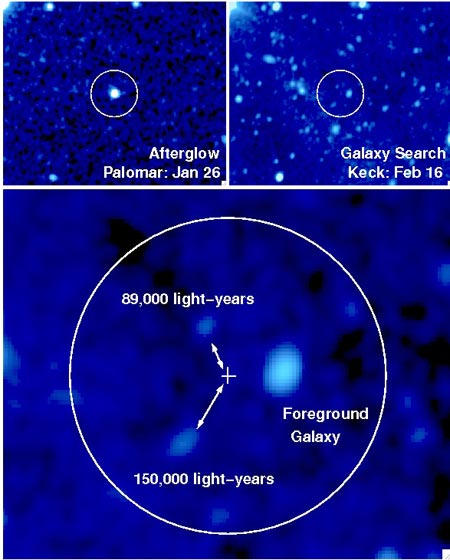Baffling Cosmic Explosion Comes Out of Nowhere

A cosmic explosion that seems to have come out of nowhere — thousands of light-years from the nearest collection of stars — has left astronomers baffled.
The blast, one of the brightest this year, was detected by spacecraft from the Inter-Planetary Network on Jan. 25 and satellites were used to pinpoint its location to a region of the sky in the constellation Gemini.
The explosion was a type called a long-duration gamma-ray burst (GRB), which are thought to be powered by the death of a massive star. But images taken after the glow of the burst, dubbed GRB 070125, had faded away showed no galaxy at the location.
"Here we have this very bright burst, yet it's surrounded by darkness on all sides," said team member Brad Cenko of the California Institute of Technology. "The nearest galaxy is more than 88,000 light-years away, and there's almost no gas lying between the burst and Earth."
Scientists used telescopes at Palomar Observatory and on Hawaii's Mauna Kea to examine the burst's spectrum, which revealed no signs of gas and dust absorbing the light of the afterglow. A trace of magnesium in the spectrum indicated that the burst took place more than 9.4 billion years ago.
Because the massive stars believed to produce GRBs live fast and die young, they don't have time to wander from their birthplace, which is usually dense clouds of gas and dust inside of galaxies. So the explosion raise the perplexing question of how a massive star could be found so far from a galaxy.
"If a massive star died far away from any galaxy, the key question is, how did it manage to be born there?" said team member Derek Fox of Penn State.
Get the Space.com Newsletter
Breaking space news, the latest updates on rocket launches, skywatching events and more!
One possibility is that the star formed in the outskirts of an interacting galaxy. To test this idea, astronomers will have to take a long exposure of the area with the Hubble Space Telescope to see if they can find the tidal tail of an interacting galaxy there.
Join our Space Forums to keep talking space on the latest missions, night sky and more! And if you have a news tip, correction or comment, let us know at: community@space.com.

Andrea Thompson is an associate editor at Scientific American, where she covers sustainability, energy and the environment. Prior to that, she was a senior writer covering climate science at Climate Central and a reporter and editor at Live Science, where she primarily covered Earth science and the environment. She holds a graduate degree in science health and environmental reporting from New York University, as well as a bachelor of science and and masters of science in atmospheric chemistry from the Georgia Institute of Technology.









